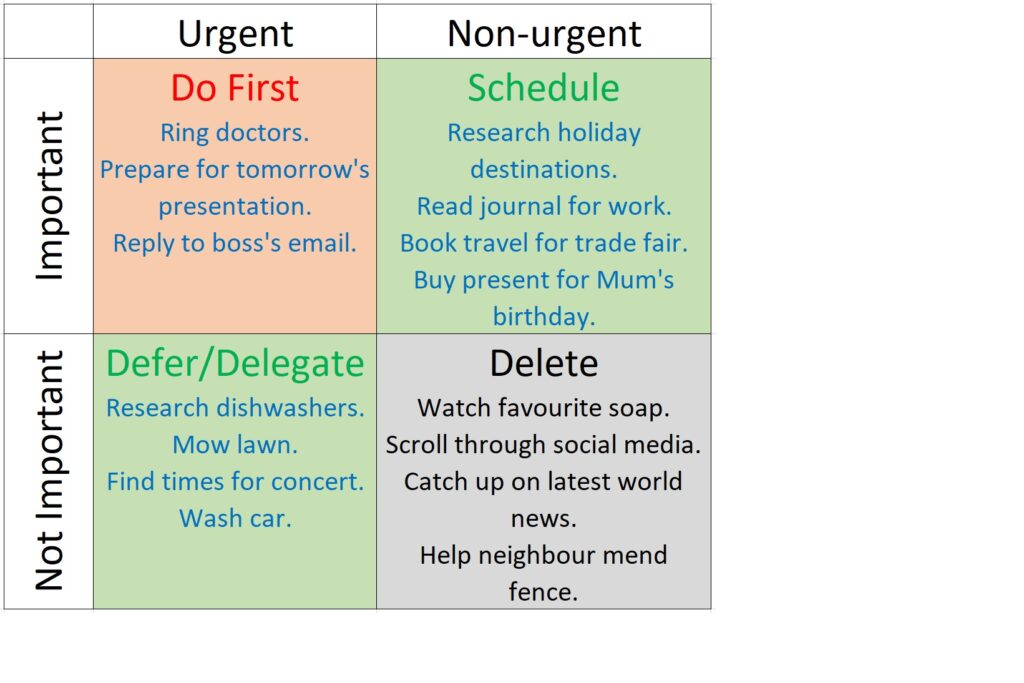You’ve got your list of interests or a massive to-do list that seems to go on for ever. You have a sense of the direction you want to go in, but… what to start with? What tasks should you make a priority and put at the top of your to-do list?
It can be overwhelming to look at the possibilities before you and work out where on earth to begin?
If you haven’t got your list in front of you and need some help working out what choices confront you, then check out the blog post Deciding on your next few steps to help you create new life choices.
This post will provide a few different ways to assess your options and choose which item on your list you will make your priority.
1. You got chills? They’re multiplying!
Have a peruse down your list and some may stick out more than others. You get that strange tingle of excitement when you mention it and it fills you with the positive vibes that open your heart and make you look forward to your future.
This is a good sign that this could well be something worth following up. Anything that gives you that buzz will be an activity that you will find plenty of motivation in starting and sticking with.
2. Decide by deadline
Which of your tasks have to be finished first? Then prioritise these first. Not rocket science at all but it deserves to be in this list, simply because we usually use this one to decide on our priorities most often. And it works. The Post Office closes at 12 and I have a parcel to send off. I also have the spare room to paint. We can do the decorating after the parcel has been sent.
3. Box it up!
This is a well known way of organising your to-do list called the Eisenhower Matrix. This helps you make decisions by their position on easy to organise the matrix. It works like this. Draw a big 2×2 grid like the one below.

Along the top of the first column, write ’urgent’ and next to it over column 2, write ’non-urgent’. Then to the left of the top row, write ’important’ and to the left of the lower row, write ’not important’. Now go through each item on your list and allocate it to one of the four boxes.
If you have organised it the same way I have described it here, you can set your intention by the titles. Items in the top left box are ones to do. Top right items need to be scheduled. Bottom left shows you what you can safely delegate, and bottom right could well be ones to be brave about and ignore/delete.
Remember, your goal is not to be busy, it is to be effective! This matrix will help you to priortise many of the to-do list items
4. Make a difference
Which of your items on your list bring very little value to your life? Will replacing your cushion covers bring more wealth, health or joy to your life than making that call to the financial advisor to up the levels of you current investment portfolio? I’m guessing that the latter will bring more value to your life than those magenta covers you’ve had you eye on for a while!
5. Long term vs short term benefits
Think about which items on your list will have benefits for you life in the long term. Short term thinking may be more of a distraction than working on your longer term goals,. So go for these first. Finding another income stream will probably have longer lasting benefits than taking the bins out. Both need to be done eventually, but perhaps one can be prioritised over the other by assessing them against this metric of long term vs short term
6. What’s your mood?
Which of the tasks match your current mood? It is well known that we go through peaks and troughs of focus and concentration levels through the day. If you know you you can crush the tough stuff between 10am and 2pm, then it makes no sense, spending that time washing up and putting the bins out. Both these activities can be done later when you have a bit of a slump in focus whilst tackling your taxes will probably need a fair bit of concentration. So do it now, while it matches your mood!
7. Winner stays on
Winner stays on is a great way to decide which items to prioritise, but a word of warning… it does take a bit of time. Think of all your tasks as football teams. They are going to play a match against each other- and the one that ’wins’, stays to play against the next team. How you decide this is up to you. Let’s say you have two tasks: cleaning the kitchen and writing your business plan. Decide which on would be the winner – and that ’team’ stays on to play against the next task on the list.
8. Get some ICE on that
This brilliant idea comes from Ton Bilyeu, the co-founder of Quest Nutrition. He uses the acronym I.C.E. to help assess how you prioritise your tasks.
Draw 5 columns down a page and write the headings: Task, Impact, Confidence , Ease and Total. Now write all your tasks in column 1.
Once you have done that, assign a number from 1-10 for each task based on its Impact (how much doing this task will affect your life), Confidence (how much confidence do I have that I can achieve this task) and Ease (how easy it is to get this done).
Scores of 0 show low ICE Scores of 10 depict high ICE scores.
Once you have finished assessing all the tasks on your list, all you have to do is add up their scores. Scores of 25+ are usually good indicators that this item is one to prioritise. Scores of less that 10 give you a sign that these can be delegated, rescheduled or deleted from your list.
The advantage of this system is that it gives you a league table of the most to the least priority tasks.
9. Get the most objectionable done first
In your list, there are probably some tasks that you don’t really feel very excited to get part in. There is some scientific thought that says if you get the one you are dreading done first, then everything else will be easy by comparison. So dredging that fish pond or tackling that tax bill may be as welcome as a snake bite in the Navadas, but you’ll feel a smug as a bug once it’s done.
10. 4:1 ratio
This uses the ratio 80:20 and refers to the fact that 80% of your consequences come from 20% of your causes and it’s called the Pareto Principle.
It states that 80% of your wealth comes from 20% of your actions, 80% of your troubles come from 20% of your customers and 80% of your profit come from 20% of your employees. This ratio can be pretty much applied to any area of your life.
So if you can work out where 80% of your successes come from, focus and prioritise those 20% of your actions.
11. Catalytic converters
Every so often you can find a lynchpin activity that changes your world and allows you to do more and be more without much extra effort. One example of this might be exercise. It is only one of the possible activities on your list, but by prioritising a daily 30 minute exercise routines, it acts as a catalyst for you begin to lose that spare tyre wound your waist and have an extra burst of energy that allows you to effortlessly make you want to change your diet to one packed with fewer treats and up the veg intake. This in turn, gives you even more energy and you find you want to be more productive, allowing you to make the changes needed to start that side hustle. Making the right change, can often ripple through your life and make it easier to become the fulfilled person you are dreaming of.
Check out the blog post about making domino decisions.
Conclusion
The perfect prioritisation method may be an amalgam of several of these ideas. The only way to know what works for you is to try things out and don’t be afraid to mix and match as you see fit.
Some of these tips and tricks may help you to decide which of your actions on your list deserve to be in your Next Few Steps. Decide which one to experiment with and schedule to try it out. The worst outcome – you’ll get something ticked off your list, the best outcome – you crush your list in a matter of hours.
What problem do you often come up against when choosing your Next Few Steps? Share your thoughts in the comments below!

